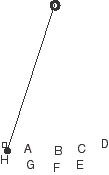Assignment:
Question 1. What is α given a = 0.365 [ms-2] and diameter of disk with uniform mass distribution = 19.1 [cm].
Question 2. Using information found in previous question, if the dropping mass is 145[g], then what is Τ?
Question 3. I have a plot whose vertical intercept is 0.00434 [Nm] If the bearings are 2 [mm] from the center of the wheel, then what is the force of friction?
Question 4. You time a pendulum for 50 cycles. Given a stopwatch reading of 2:47.92, what is the period (in seconds)?
Question 5. According to the relationship between torque and angular acceleration, what happens when you have more torque (given a constant rotational inertia)?
- The angular acceleration decreases.
- Not enough information to know.
- The angular acceleration stays constant.
- The angular acceleration increases
Question 6. Data's vertical intercept should exist directly because of:
- friction between string and big wheel
- my lab partner messing up the data
- mass of string
- frictional force
- extra mass of pulley
- the torque due to friction; τfriction
Question 7. Which of the following will increase the period?
- Shorter Length and Less Mass
- Longer Length
- Shorter Length
- Longer Length and Greater Mass
- Longer Length, Greater Mass, and 3 Degree Greater Angle
- 3 Degree Greater Angle
- Greater Mass
- Less Mass
Question 8. Given that the pendulum starts at the black box on the left, at what position(s) has the pendulum completed one period?

Question 9. What two points define the length of this pendulum? Write your answer like this M-P.
